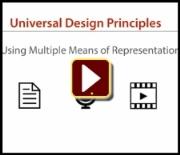Why Accessibility Matters?
To learn more about the foundations of accessibility, watch the introductory videos below:
- IT Accessibility: What Campus Leaders Have to Say (Audio described version)
- Videos created by CSU ATI
- "From Where I Sit" Video Series
Accessibility Statement
California State University, Northridge (CSUN) is committed to ensuring that the campus web environment is accessible to everyone. As a community, we work together to address the usability and accessibility of the web sites contained within CSUN’s web environment.
Read more about CSUN's accessibility statement.
Mission
Our mission is to assist the campus community in creating pathways for individuals to learn, communicate, and share via information technology. Part of the mission is to help the campus community design-in interoperability, usability, and accessibility into information technology so that individual learning and processing styles, or physical characteristics are not barriers to accessing information.
The role of the UDC is to help CSUN implement business practices which enables the campus to meet policy standards within the Accessible Technology Initiative Coded Memorandum AA-2013-03.
How does Universal Design relate to ATI?
The principles of Universal Design are based on teaching to all students regardless of their individual processing styles or characteristics (CAST, 2014). Disability is just one of many characteristics that an individual may possess. Designing ways to access information and technology in a fashion that is usable to everyone helps support the California State University's (CSU) ongoing commitment to provide access for individuals with disabilities. More information can be found at The Trace Center's Accessibility/Universal Design Information.
Shared Campus Responsibility: What does this mean to me?
Everyone has a part in creating accessible, usable information. The responsibility of creating and maintaining accessible content falls to the entire campus community.
Learn more about your part in sharing the responsibility as outlined in the CSU ATI Coded Memorandum.

